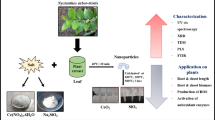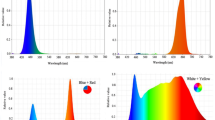Abstract
The present study analyzes some effects of nano-CeO2 particles on the growth of in vitro plantlets of Medicago arborea when the nanoceria was added to the culture medium. Various concentrations of nano-CeO2 and bulk ceric oxide particles in suspension form were introduced to the agar culture medium to compare the effects of nanoceria versus ceric oxide bulk material. Germination rate and shoot dry weight were not affected by the addition of ceric oxide to the culture media. Furthermore, no effects were observed on chlorophyll content (single-photon avalanche diode (SPAD) measurements) due to the presence of either nano- or micro-CeO2 in the culture medium. When low concentrations of nanoceria were added to the medium, the number of trifoliate leaves and the root length increased but the root dry weight decreased. Also the values of maximum photochemical efficiency of PSII (F v/F m) showed a significant decrease. Dark-adapted minimum fluorescence (F 0) significantly increased in the presence of 200 mg L−1 nanoceria and 400 mg L−1 bulk material. Root tissues were more sensitive to nanoceria than were the shoots at lower concentrations of nanoceria. A stress effect was observed on M. arborea plantlets due to cerium uptake.





Similar content being viewed by others
Abbreviations
- F 0 :
-
Dark-adapted minimum fluorescence
- F v :
-
Variable fluorescence
- F m :
-
Maximum fluorescence
- ICP-AES:
-
Inductively coupled plasma-atomic emission spectroscopy
- NP:
-
Nanoparticle
- PAM:
-
Pulse amplitude modulated
- REEs:
-
Rare earth elements
- SPAD:
-
Single-photon avalanche diode
References
Pilon-Smits EAH, Quinn CF, Tapken W, Malagoli M, Schiavon M (2009) Physiological functions of beneficial elements. Curr Opin Plant Biol 12:267–274
Yin S, Ze Y, Liu C, Li N, Zhou M, Duan Y, Hong F (2009) Cerium relieves the inhibition of nitrogen metabolism of spinach caused by magnesium deficiency. Biol Trace Elem Res 132:247–258
He YW, Loh CS (2000) Cerium and lanthanum promote floral initiation and reproductive growth of Arabidopsis thaliana. Plant Sci 159:117–124
Hu QH, Ye ZJ (1996) Physiological effects of rare earth elements on plants. Plant Physiol Comm 32(4):296–300
Darlington TK, Neigh AM, Spencer MT, Nguyen OT, Oldenburg SJ (2009) Nanoparticle characteristics affecting environmental fate and transport through soil. Environ Toxicol Chem 28(6):1191–1199
Zhang P, Ma Y, Zhang Z, He X, Guo Z, Tai R, Ding Y, Zhao Y, Chai Z (2012) Comparative toxicity of nanoparticulate/bulk Yb2O3 and YbCl3 to cucumber (Cucumis sativus). Environ Sci Technol 46(3):1834–1841
Metzler DM, Erdem A, Tseng YH, Huang CP (2012) Responses of algal cells to engineered nanoparticles measured as algal cell population, chlorophyll a, and lipid peroxidation: effect of particle size and type. J Nanotech Article ID 237284, 12 pages doi:10.1155/2012/237284
López-Moreno ML, de la Rosa G, Hernández-Viezcas JA, Peralta-Videa JR, Gardea-Torresdey JL (2010) XAS corroboration of the uptake and storage of CeO2 nanoparticles and assessment of their differential toxicity in four edible plant species. J Agr Food Chem 58(6):3689–3693
U.S. Environmental Protection Agency (1996) Ecological effects test guidelines (OPPTS 850.4200): seed germination/root elongation toxicity test. EPA 712–C–96-154. Washington, DC.
Remedios C, Rosario F, Bastos V (2012) Environmental nanoparticles interactions with plants: morphological, physiological, and genotoxic aspects. J Bot Article ID 751686, 8 pages doi:10.1155/2012/751686
Diatloff E, Smith FW, Asher CJ (2008) Effects of lanthanum and cerium on the growth and mineral nutrition of corn and mungbean. Ann Bot-London 101(7):971–982
López-Moreno ML, de la Rosa G, Hernández-Viezcas JA, Castillo-Michel Botez CH, Peralta-Videa JR, Gardea-Torresdey JL (2010) Evidence of the differential biotransformation and genotoxicity of ZnO and CeO2 nanoparticles on soybean (Glycine max) plants. Environ Sci Technol 44(19):7315–7320
Weiping S, Fashui H, Zhigang W, Yuzhen Z, Fugen G, Hongoing X, Mingliang Y, Youhong C, Mizhen Z, Jiale S (2003) Effects of cerium on nitrogen metabolism of peach plantlet in vitro. Biol Trace Elem Res 95:256–268
Martín JP, Pintos B, Rebordinos I, Villalobos N, Guerra H, Martín L (2000) Embryogenic response in different Medicago arborea L. explants depending on cytokinin/auxin balances. J Plant Physiol 165:801–804
Lee W-M, An Y-J, Yoon H, Kweon H-S (2008) Toxicity and bioavailability of copper nanoparticles to the terrestrial plants mung bean (Phaseolus radiatus) and wheat (Triticum aestivum): plant agar test for water-insoluble nanoparticles. Environ Toxicol Chem 27:1915–1921
OECD (2006) Test No. 208: Terrestrial plant test: seedling emergence and seedling growth test. OECD Guidelines for the Testing of Chemicals, Section 2. OECD Publishing. doi: 10.1787/9789264070066-en
Murashige T, Skoog F (1962) A revised medium for rapid growth and bioassays with tobacco tissue cultures. Physiol Plantarum 15:473–497
Fang S, Sun W, Hu H, Zhang H, Zheng K (2012) Chlorophyll content of barley (Hordeum vulgare L.) estimation from leaf SPAD, chlorophyll fluorescence and reflectance properties. Adv Sci Lett 11:702–705
Garate A, Ramón AM, Carpena OR (1984) Influencia del boro sobre el manganeso y otros nutrientes en extractos de tejidos vasculares. Annales de Edafología y Agrobiología 43(9–10):1467–1477
Stampoulis D, Sinha SK, White JC (2009) Assay-dependent phytotoxicity of nanoparticles to plants. Environ Sci Technol 43(24):9473–9479
Ma C, Chhikara S, Xing B, Musante C, White JC, Dhankher OP (2013) Physiological and molecular response of Arabidopsis thaliana (L.) to nanoparticle cerium and indium oxide exposure. ACS Sustain Chem Eng. doi:10.1021/sc400098h
Shyam R, Aery NC (2011) Effect of cerium on seed germination and early seedling growth of wheat. NBU J Plant Sci 5:51–55
Shyam R, Aery NC (2012) Effect of cerium on growth, dry matter production, biochemical constituents and enzymatic activities of cowpea plants [Vigna unguiculata (L.) Walp.]. J Soil Sci Plant Nutr 12(1):1–14
Xia T, Kovochich M, Liong M, Zink JI, Nel AE (2008) Comparison of the mechanism of toxicity of zinc oxide and cerium oxide nanoparticles based on dissolution and oxidative stress properties. ACS Nano 2(10):2121–2134
Heckert EG, Karakoti AS, Seal S, Self WT (2008) The role of cerium redox state in the SOD mimetic activity of nanoceria. Biomaterials 29:2705–2709
Rico CM, Morales MI, McCreary R, Castillo-Michel H, Barrios AC, Hong J, Tafoya A, Lee WY, Varela-Ramirez A, Peralta-Videa JR, Gardea-Torresdey JL (2013) Cerium oxide nanoparticles modify the antioxidative stress enzyme activities and macromolecule composition in rice seedlings. Environ Sci Technol 47:14110–14118
Asli S, Neumann PM (2009) Colloidal suspensions of clay or titanium dioxide nanoparticles can inhibit leaf growth and transpiration via physical effects on root water transport. Plant Cell Environ 32:577–584
Prieto P, Peñuelas J, Llusia J, Asensio D, Estiarte M (2009) Effects of long-term experimental night-time warming and drought on photosynthesis, Fv/Fm and stomatal conductance in the dominant species of a Mediterranean shrubland. Acta Physiol Plant 31:729–739
Rodea-Palomares I, Gonzalo S, Santiago-Morales J, Leganes F, Garcia-Calvo E, Rosal R, Fernandez-Pinas F (2012) An insight into the mechanisms of nanoceria toxicity in aquatic photosynthetic organisms. Aquat Toxicol 122:133–143
Rohácek K (2002) Chlorophyll fluorescence parameters: the definitions, photosynthetic meaning, and mutual relationships. Photosynthetica 40:13–29
Maxwell K, Johnson GN (2000) Chlorophyll fluorescence: a practical guide. J Exp Bot 51:659–668
Fracheboud Y, Jompuk C, Ribaut JM, Stamp P, Leipner J (2004) Genetic analysis of cold-tolerance of photosynthesis in maize. Plant Mol Biol 56:241–253
Krause GH, Weiss E (1991) Chlorophyll fluorescence and photosynthesis; the basics. Annu Rev Plant Phys 42:313–349
Bjorkman O, Demmig B (1987) Photon yield for O2 evolution and chlorophyll fluorescence characteristics at 77 K among vascular plants of diverse origins. Planta 170:489–504
Gholamin R, Khayatnezhad M (2011) The effects of water and salt stresses on germination in two bread wheat genotypes. Ar J Biotech 10(77):17805–17811
Bounfour M, Tanigoshi LK, Chen C, Cameron SJ, Klauer S (2002) Chlorophyll content and chlorophyll fluorescence in red raspberry leaves infested with Tetranychus urticae and Eotetranychus carpini borealis (Acari: Tetranychidae). Environ Entomol 31(2):215–220
Ma X, Geiser-Lee J, Deng Y, Kolmakov A (2010) Interactions between engineered nanoparticles (ENPs) and plants: phytotoxicity, uptake and accumulation. Sci Total Environ. doi:10.1016/j.scitotenv.2010.03.031
Author information
Authors and Affiliations
Corresponding author
Rights and permissions
About this article
Cite this article
Gomez-Garay, A., Pintos, B., Manzanera, J.A. et al. Uptake of CeO2 Nanoparticles and Its Effect on Growth of Medicago arborea In Vitro Plantlets. Biol Trace Elem Res 161, 143–150 (2014). https://doi.org/10.1007/s12011-014-0089-2
Received:
Accepted:
Published:
Issue Date:
DOI: https://doi.org/10.1007/s12011-014-0089-2




